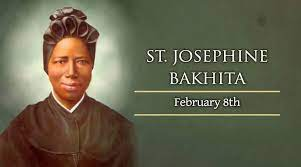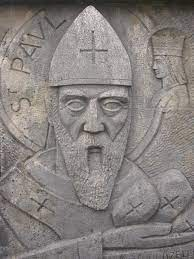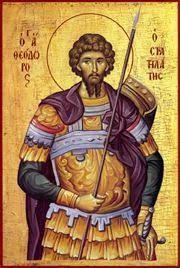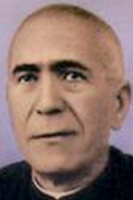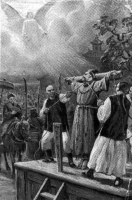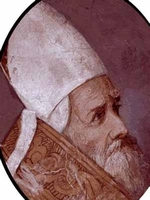St. Nicetius of Besancon
Feastday: February 8
B ishop of Besancon. He was a friend of St. Columbanus of Luxeuil. Nicetius had to restore his see after an invasion of Huns.
St. Jacut and Guethenoc
Feastday: February 8
Death: 5th century
Disciples of St. Budoc, sons of Sts. Fagan and Gwen, and brothers of St. Gwenaloe. They were forced to leave Britain by invading Saxons, probably going with Budoc to Brittany.
St. Llibio
Feastday: February 8
Death: 6th century
The patron saint of Llanlibio on Anglesey Island, Wales.
St Llibio's Church, Llanllibio is a demolished church in Anglesey, north Wales. Founded by Llibio in the sixth century, the church served a small community of bondmen as a chapel of ease. The population of Llanllibio declined substantially during the Middle Ages as a result of the Black Death and changes in farming practice, amongst other factors, and the community that the church served effectively disappeared. As a result, St Llibio's closed in the seventeenth century; the remaining worshippers moved to another local church.
Plans in the nineteenth century to rebuild the church, which was in ruins by 1776, came to nothing. Except for a memorial stone, nothing more than "tiny traces" of St Llibio's can now be seen.[1]
Early history
St Llibio's was the church for Llanllibio in Anglesey, north Wales. A survey of Anglesey conducted in 1352 records Llanllibio as a tir cyfrif township, a Welsh form of land tenure in which the inhabitants, who were generally few in number, were bondmen working for the lord in return for a small arable holding and some grazing rights.[2] It was the only tir cyfrif township in Anglesey to have a church.[3] Like many other communities in Anglesey, and elsewhere in medieval Wales, Llanllibio's population decreased substantially during the Middle Ages, and the settlement effectively disappeared. Communities such as Llanllibio were affected by the Black Death, the destruction resulting from the revolt of Owen Glyndwr, by changes in land tenure, and by new farming practices that reduced the need for tied labour.[4]
The parish was on the old road between London and the Anglesey port town of Holyhead, and about 0.8 miles (1.3 km) from Bodedern.[5] The church was dedicated to St Llibio, a sixth-century monk, confessor, and disciple of the Anglesey saint Cybi.[6][7] Llibio himself is recorded as having founded a church on the site, and his feast day was celebrated on 28 February.[6][7] The area took its name from the church: the Welsh word "llan" originally meant "enclosure" and then "church".[8]
St Llibio's was used as a chapel of ease to the Church of St Afran, St Ieuan and St Sannan, Llantrisant, about 1.5 miles (2.4 km) away.
Saint Josephine Bakhita
புனிதர் ஜோசஃபின் மார்கரெட் பகிட்டா
(St. Josephine Margaret Bakhita)
சூடானில் பிறந்த முன்னாள் அடிமைப்பெண்/ கனோஸ்ஸியன் சபை அருட்சகோதரி:
(Sudanese-born Former Slave/ Canossian Religious Sister)
பிறப்பு: கி.பி. 1869
ஒல்கொஸ்ஸா, டர்ஃபுர், சூடான்
(Olgossa, Darfur, Sudan)
இறப்பு: ஃபெப்ரவரி 8, 1947
ஸ்ச்சியோ, வெனேடோ, இத்தாலி குடியரசு
(Schio, Veneto, Republic of Italy)
ஏற்கும் சமயம்:
ரோமன் கத்தோலிக்க திருச்சபை
(Roman Catholic Church)
முக்திப்பேறு பட்டம்: மே 17, 1992
திருத்தந்தை இரண்டாம் ஜான் பால்
(Pope John Paul II)
புனிதர் பட்டம்: அக்டோபர் 1, 2000
திருத்தந்தை இரண்டாம் ஜான் பால்
(Pope John Paul II)
நினைவுத் திருநாள்: ஃபெப்ரவரி 8
பாதுகாவல்:
சூடான்
(Sudan)
புனிதர் ஜோசஃபின் மார்கரெட் பகிட்டா, சூடான் நாட்டில் பிறந்த ஒரு முன்னாள் அடிமைப்பெண்ணும், பின்னர், "கனோஸ்ஸியன் அருட்சகோதரிகள்" (Canossian Religious Sister) சபையின் உறுப்பினராக இத்தாலியில் வாழ்ந்து, பணியாற்றிய ரோமன் கத்தோலிக்க திருச்சபையின் புனிதருமாவார்.
ஆரம்ப கால வாழ்க்கை:
கி.பி. 1869ம் ஆண்டு, “மேற்கத்திய சூடான்” (Western Sudanese Region) நாட்டின் "டர்ஃபுர்" (Darfur) பிராந்தியத்தின் “ஒல்கொஸ்ஸா” (Olgossa) கிராமத்தில் பிறந்த ஜோசஃபின், ஒரு வசதியான - கௌரவமிக்க குடும்பத்தைச் சேர்ந்தவர் ஆவார். அன்புமிக்க மூன்று சகோதரர்களுடனும், சகோதரிகளுடனும் பிறந்த இவர், கஷ்டம் என்றாலே என்னவென்று அறியாமல் வளர்ந்தார்.
இவருக்கு சுமார் எட்டு வயதாகையில், கி.பி. 1877ம் ஆண்டு, ஃபெப்ரவரி மாதம், இவர் அரேபிய அடிமை வர்த்தகர்களால் கடத்தப்பட்டார். இவர்கள் ஏற்கனவே இரண்டு வருடங்களுக்கு முன்னர், இவரது மூத்த சகோதரியையும் கடத்தியிருந்தனர். மிகவும் குரூரமான முறையில், சுமார் 960 கிலோமீட்டர் தூரம் வெறும் கால்களுடன் "இய் ஒபேய்ட்" (El Obeid) என்ற நகரம் நோக்கி நடக்க வைக்கப்பட்டார். அந்நகரத்துக்கு சேரும்முன்னேயே அவர் இரண்டு தடவை விற்கப்பட்டார். அடிமையாக இருந்த சுமார் பன்னிரண்டு வருட காலத்தில் மீண்டும் மீண்டுமாக மூன்று முறை அவர் விற்கப்பட்டார். அவருக்கு நேர்ந்த கடத்தல்களும், அதன் காரணமான அதிர்ச்சிகளும், அவரது சொந்த பெயரைக் கூட அவர் மறக்க காரணமாயின. எதோ ஒரு அடிமை வியாபாரி அவருக்கு இட்ட பெயரான "பகிட்டா" (Bakhita) என்ற பெயரையே அவரும் தேர்ந்துகொண்டார். "பகிட்டா" (Bakhita) என்றால் அரபு மொழியில் அதிர்ஷ்டசாலி என்று அர்த்தமாம். ஜோசஃபின் வலுக்கட்டாயமாக இஸ்லாம் (Islam) மதத்துக்கும் மாற்றப்பட்டார்.
அடிமை வாழ்க்கை:
"இய் ஒபேய்ட்" (El Obeid) நகரில் ஜோசஃபின் ஒரு பணக்கார அரேபியரால் அடிமை வர்த்தகர்களிடமிருந்து வாங்கப்பட்டார். அவர் அங்கே அரேபியரின் இரண்டு மகள்களுக்கு சேவை செய்யும் பணியில் அமர்த்தப்பட்டார். அவர்கள் பகிட்டாவை நல்ல முறையில் கவனித்தனர். ஆனால், ஒரு தடவை குவளையொன்று உடைந்து போன ஒரு காரணத்துக்காக, அந்த அரேபியனின் மகன்களில் ஒருவன் பகிட்டாவை மிகவும் மோசமாக அடித்து உதைத்து துன்புறுத்தினான். மிகவும் மோசமாக பாதிக்கப்பட்ட பகிட்டா, ஒரு மாதத்துக்கும் மேலாக தமது வைக்கோல் படுக்கையிலிருந்து நகர இயலாமலிருந்தார்.
நான்காவது தடவியாக, இவரை ஒரு துருக்கிய இராணுவ அதிகாரி (Turkish General) வாங்கினார். இவர் தமது மனைவி மற்றும் மாமியாருக்கு சேவை செய்ய பகிட்டாவை நியமித்தார். இவரது மனைவியும், மாமியாரும் பகிட்டாவுக்கு செய்த கொடுமைகளுக்கு அளவே இல்லை. தாம் அந்த வீட்டிலிருந்த வருடங்களில், அடியோ காயமோ படாமல் கழிந்த ஒருநாளைக் கூட என்னால் நினைவு படுத்தி பார்க்க இயலவில்லை என்று ஜோசஃபின் கூறுகிறார். சாட்டை அடியால் பட்ட ஒரு காயம் ஆற ஆரம்பிக்கும் முன்னேயே அடுத்த காயம் வந்துவிடும் என்கிறார்.
தமக்கு நேர்ந்த மிகவும் திகிலூட்டும் சம்பவத்தை ஜோசஃபின் பின்வருமாறு விவரிக்கிறார்:
உடலில் பச்சை குத்துவதற்கான வடிவங்களை அமைத்து தமது எஜமானியரிடம் காண்பிப்பது இவரது அன்றாட பணிகளுள் ஒன்று. வேறொரு அடிமைப்பெண் ஒரு கிண்ணத்தில் வெண்ணிற மாவும், மற்றொரு கிண்ணத்தில் உப்புத்தூளும், மிகவும் கூரிய (பிளேடு) போன்ற கத்தியும் கொண்டு வருவார். பகிட்டா, வெண்ணிற மாவினால் தம் உடலில் பச்சை குத்துவதற்கான வடிவங்களை வரைவார். உடனே கூறிய கத்தியால் மாவு கோலங்களின் கோடுகள் மீது ஆழமாக கீறுவார். இரத்தம் வெளியேறும் முன்னேயே, ஆழமான தழும்புகளுக்காக உப்புத் தூளை அதில் நிரப்ப வேண்டும். ஜோசஃபினின் உடம்பில் மார்பகங்கள், வயிறு, மற்றும் வலது கரத்தில் மொத்தம் 114 சிக்கலான வடிவங்கள் இருந்தன.
கி.பி. 1882ம் ஆண்டின் இறுதியில் "இய் ஒபேய்ட்" (El Obeid) நகரம் "மாஹ்டிஸ்ட் புரட்சியாளர்களின்" (Mahdist Revolutionaries) தாக்குதலுக்கு உட்படும் அச்சுறுத்தல் ஏற்பட்டது. இதன்காரணமாக, நகரை விட்டு குடும்பத்துடன் கிளம்பிய துருக்கிய இராணுவ அதிகாரி, பத்து அடிமைகளை மட்டும் தம்முடன் வைத்துக்கொண்டு பிறரை அங்கேயே விற்றுவிட்டான். தம்முடனிருந்தவர்களை வழியில் விற்றுவிட முடிவு செய்திருந்தான். கி.பி. 1883ம் ஆண்டு, பகிட்டாவை இத்தாலிய நாட்டின் பிரதிநிதியான (Italian Vice Consul) "கல்லிஸ்டோ லெக்னானி" (Callisto Legnani) என்பவர் வாங்கினார். அவர் பகிட்டாவை மிகவும் பிரியமாகவும் கௌரவமாகவும் நடத்தினார்.
இரண்டு வருடங்களின் பின்னர் "கல்லிஸ்டோ லெக்னானி" இத்தாலி திரும்ப முடிவெடுத்தபோது, பகிட்டா தாமும் அவருடன் வருவதாக கெஞ்சினார். கி.பி. 1884ம் ஆண்டின் இறுதியில், "அகஸ்டோ மிச்சியெலி" (Augusto Michieli) என்ற நண்பரின் உதவியால் முற்றுகையிடப்பட்டிருந்த "கார்ட்டும்" (Khartoum) நகரிலிருந்து அவர்கள் தப்பிச் சென்றார்கள். 650 கி.மீ. தூரம் ஒரு ஒட்டகத்தின்மீது ஆபத்தான பயணம் செய்து, அப்போதைய சூடான் நாட்டின் துறைமுக நகரான "சுவகின்" (Suakin) சென்றடைந்தனர். கி.பி. 1885ம் ஆண்டு, மார்ச் மாதம், அங்கிருந்து கிளம்பி ஏப்ரல் மாதம், இத்தாலிய துறைமுக நகரான ஜெனோவா (Genoa) சென்றடைந்தனர். அவர்கள் அங்கே "அகஸ்டோ மிச்சியெலியின்" மனைவி "சிக்னோரா மரியா டுரினா மிச்சியெலியை" (Signora Maria Turina Michieli) சந்தித்தனர். "கல்லிஸ்டோ லெக்னானி" பகிட்டாவை "சிக்னோரா மரியாவிடம்" கையளித்தார்.
பகிட்டா தமது புதிய எஜமானருடன் அவரது இருப்பிடமான "ஸியானிகோ" (Zianigo) சென்றார். அங்கே மிச்சியெலியின் புதிதாய் பிறந்த குழந்தை "அலைஸுக்கு" (Alice) செவிலித்தாயாக மூன்று வருடம் பணிபுரிந்தார். மிச்சியெலி இத்தாலி திரும்புவதன் முன்னர், ஒன்பது மாதங்களுக்காக பகிட்டாவையும் தம்முடன் சூடான் அழைத்து வந்தார்.
கத்தோலிக்க மனமாற்றமும் சுதந்திரமும்:
சூடான் நாட்டின் "சுவக்கின்" (Suakin) முற்றுகையிடப்பட்டிருந்தது. ஆனால் அது இன்னமும் "ஆங்கிலோ-எகிப்தியர்களின்" (Anglo-Egyptian) கைகளிலேயே இருந்தது. "அகஸ்டோ மிச்சியெலி" அங்கே ஒரு பெரிய ஓட்டலை வாங்கினார். அவர் இத்தாலியிலுள்ள தமது மொத்த சொத்துக்களையும் விற்றுவிட்டு தமது குடும்பத்துடன் சுவக்கினில் தங்கிவிட முடிவு செய்தார். சொத்துக்களை விற்பது அவருக்கு அவ்வளவு சுலபமாக இல்லை. அவரது மனைவி சிக்னோரா அவர்களது "ஸியானிகோ" இல்லத்தை விற்றுவிட்டார். மீதமுள்ள சொத்துக்களை விற்குமுன் அவர் தமது கணவரை காண சுவக்கின் சென்றார். செல்லுமுன் தமது குழந்தையையும் பகிட்டாவையும் “வெனிஸ்” (Venice) நகரிலுள்ள "கனோஸ்ஸியன் சகோதரிகள் சபையின்" (Canossian Sisters) பாதுகாப்பில் விட்டுச் சென்றார்.
சுவக்கினிலிருந்து திரும்பிய சிக்னோரா, பகிட்டாவுடன் தமது குழந்தையை அழைத்துச் செல்ல வந்தார். பகிட்டா அங்கிருந்து வெளியேற தீர்க்கமாக மறுத்துவிட்டார். மூன்று நாட்கள் முழுதாக அன்பாகவும், அதட்டியும், மிரட்டியும், முயற்சித்த சிக்னோரா தோற்றுப்போனார். "கனோஸ்ஸியன் சகோதரிகள் சபையின்" தலைமைச் சகோதரி, பிரச்சினையை இத்தாலிய அரசு அதிகாரிகளிடம் கொண்டு சென்று புகார் செய்தார். கி.பி. 1889ம் ஆண்டு, நவம்பர் மாதம், 29ம் தேதி, இத்தாலிய நீதிமன்றமொன்று, ஏற்கனவே பிரிட்டிஷ் அடிமைத்தளைக்கு தடை விதிக்குமாறு சூடான் நாட்டை தூண்டிஇருந்தது. அத்துடன், இத்தாலி நாட்டில் அடிமைகளுக்கு அங்கீகாரம் கிடையாது. ஆகவே பகிட்டா அடிமை இல்லை என்று தீர்ப்பு வழங்கியது.
தமது வாழ்க்கையில் முதன்முதலாக சுதந்திரத்தை பகிட்டா அனுபவித்தார். அவர் "கனோஸ்ஸியன் சகோதரிகள் சபையிலேயே" இருக்க விரும்பினார். கி.பி. 1890ம் ஆண்டு, ஜனவரி மாதம், ஒன்பதாம் நாள், பகிட்டா, "ஜோசஃபின் மார்கரெட் மற்றும் ஃபோர்டுனடா" (Josephine Margaret and Fortunata) ஆகிய பெயர்களுடன் திருமுழுக்கு பெற்றார். “வெனிஸ் பேராயர்-கர்தினால்” (Cardinal Patriarch of Venice) "ஜியுசெப் சர்டோ" (Giuseppe Sarto) (எதிர்கால திருத்தந்தை பத்தாம் பயஸ் - Future Pope Pius X) அவர்களது திருக்கரங்களால் உறுதிப்பூசுதலும் புதுநன்மையும் பெற்றார்.
கனோஸ்ஸியன் அருட்சகோதரி:
ஜோசஃபின் கி.பி. 1893ம் ஆண்டு, டிசம்பர் மாதம், ஏழாம் நாள், "கனோஸ்ஸியன் சகோதரியர் துறவற" சபையில் இணைந்தார். கி.பி. 1896ம் ஆண்டு, டிசம்பர் மாதம், எட்டாம் நாள், தமது பிரமாணங்களை ஏற்றார். அவர் இத்தாலியின் வடக்குப் பிராந்தியமான "விசென்ஸாவின்" (Vicenza) "ஸ்ச்சியோ" (Schio) என்னுமிடத்திலுள்ள கனோஸ்ஸியன் பள்ளியில் சேவை செய்ய பணிக்கப்பட்டார். அவர் தமது மீதமிருந்த வாழ்நாள் முழுவதும் அங்கேயே செலவிட்டார். ஜோசஃபின் அங்கிருந்த 42 வருடங்களும் ஒரு சமையல்கார பெண்ணாகவும், தேவாலயத்தில் உள்ள புனிதப் பொருட்களைக் காப்பவராகவும், சுமை சுமப்பவராகவும், காவல்காரராகவும், வாயிற்காக்கும் பெண்ணாகவும், உள்ளூர் சமூகத்தினரிடம் அடிக்கடி தொடர்புகொள்ளும் பணியையும் செய்தார். இவ்வருட்சகோதரியின் மேன்மையான மென்மை, அமைதியான குரல் மற்றும் அவரது வதனத்திலே தங்கிவிட்ட நிரந்தர புன்னகை ஆகியன, அவரை “விசென்ஸா” (Vicenza) நகர மக்களுடன் நீக்கமற இணைத்தன. இந்நகர மக்கள் இன்றளவும் இவரை “சின்னஞ்சிறு பழுப்பு சகோதரி” (“Sor Moretta” - Little Brown Sister) என்றும், “கருப்பு அன்னை” ("Madre Moretta" - Black Mother) என்றும் குறிப்பிடுகின்றனர்.
கடவுளால் அருளப்பட்ட கொடையான இவருடைய அதிர்ந்து பேசாத சிறப்பும், புனிதமான புகழும், இவர் சார்ந்திருந்த துறவற சபையால் குறிக்கப்பட்டது. கி.பி. 1931ம் ஆண்டு வெளிவந்த அவரது சுயசரிதம் தொடர்பான பதிப்பு அவரது புகழை இத்தாலி முழுதும் பரவச் செய்தது. இரண்டாம் உலகப்போரின்போது, (கி.பி. 1939–1945) நகர மக்களின் பயத்தை போக்க ஆறுதலாக இருந்தார். நகர மக்கள் இவரின் அருகாமை, ஒரு புனிதரின் பாதுகாப்பாக உணர்வதாக கூறினர். "ஸ்ச்சியோ" (Schio) நகரமும் குண்டு வீச்சிலிருந்து தப்பவில்லை. ஆனால் இரண்டாம் உலகப்போர், ஒரு விபத்தோ அல்லது எவருக்கேனும் ஒரு காயமோ இன்றி கடந்து போனது.
ஜோசஃபினுடைய இறுதி ஆண்டுகள் நோயாலும், வேதனையாகவும் இருந்தன. அவர் ஒரு சக்கர நாற்காலியை உபயோகித்தார். ஆனால் எப்போதும் புன்முறுவலுடன் இருந்தார். எப்படி இருக்கிறீர்கள் என்று யார் கேட்டாலும் புன்முறுவலுடன் "இறைவனின் விருப்பப்படி" (As the Master’s desires) என்றே பதிலளிப்பார்.
அவரது இறுதி மணித்துளிகளில் அவர் தமது ஆரம்ப கால அடிமை வாழ்க்கையை நினைத்து மிகவும் வருந்தினார். "சங்கிலிகள் மிகவும் இறுக்குகின்றன, கொஞ்சம் தளர்த்துங்களேன்" என்று சொல்லி அழுதார்.
எவரோ ஒருவர், "இன்று சனிக்கிழமை; எப்படி இருக்கிறீர்கள்?" என்று கேட்டதற்கு ஜோசஃபின், "ஆமாம், நான் மகிழ்ச்சியாக இருக்கிறேன்; என் அன்னையே, என் அன்னையே" என்றார். அவரிடமிருந்து கேட்ட இறுதி வார்த்தைகள் இவையே ஆகும்.
1947ம் ஆண்டு, ஃபெப்ரவரி மாதம், எட்டாம் நாளன்று, இரவு 8:10 மணிக்கு, ஜோசஃபின் மார்கரெட் பகிட்டா, நித்திய வாழ்வில் சயனித்தார். அன்னாரது பூவுடல், மூன்று நாட்கள் பொதுமக்களின் அஞ்சலிக்காக வைக்கப்பட்டிருந்தது.
"சிறு வயதில் உங்களை கடத்தியவரகளை நீங்கள் சந்திக்க நேர்ந்தால் என்ன செய்வீர்கள்?" என்று, ஒருமுறை, ஒரு இளம் மாணவன் ஜோசஃபினை நோக்கி கேட்டான்.
சிறிதும் தயங்காமலும் யோசிக்காமலும் ஜோசஃபின் கூறிய பதில்:
“என்னை கடத்தியவர்கள் மட்டுமல்லாது, என்னை துன்புறுத்தி வதைத்தவர்களையும் நான் காண நேரிட்டால், நான் அவர்கள் முன்னே முழங்கால்படியிட்டு, அவர்களின் கரங்களைப் பற்றி முத்திசெய்வேன். இவைகள் என் வாழ்வில் நிகழ்ந்திராவிடில், நான் இன்று ஒரு கிறிஸ்தவளாகவோ, மறைப்பணியாளாகவோ ஆகியிருக்க மாட்டேன்!"
Also known as
• Giuseppina Bakhita
• Madre Moretta
• Sister Moretta
Profile
Born to a wealthy Sudanese family, she was kidnapped by slave-traders at age 9, and given the name Bakhita (lucky) by them. Sold and resold in the markets at El Obeid and Khartoum, finally purchased in 1883 by Callisto Legnani, Italian consul who planned to free her. She accompanied Legnani to Italy in 1885, and worked as a nanny for the family of Augusto Michieli. She was treated well in Italy and grew to love the country. An adult convert the Christianity, she joined the Church on 9 January 1890, she took the name of Josephine as a symbol of her new life.
She entered the Institute of Canossian Daughters of Charity in Venice, Italy in 1893, taking her vows on 8 December 1896 in Verona, Italy and serving as a Canossian Sister for the next fifty years. Her gentle presence, her warm, amiable voice, and her willingness to help with any menial task were a comfort to the poor and suffering people who came to the door of the Institute. After a biography of her was published in 1930, she became a noted and sought after speaker, raising funds to support missions.
Her feast has been designated the International Day of Prayer to Stop Human Trafficking.
Born
1868 at Oglassa, Darfur, Sudan
Died
8 February 1947 of natural causes in Italy
Canonized
• 1 October 2000 by Pope John Paul II at Saint Peter's Basilica, Rome, Italy
• thought to be the only saint originally from Sudan
Patronage
Sudan
Saint Jerome Emiliani
புனிதர் ஜெரோம் எமிலியானி
(St. Jerome Emiliani)
மனிதாபிமானி மற்றும் “சோமாஸ்ச்சி” தந்தையர் சபை நிறுவனர்:
(Humanitarian and Founder of the Somaschi Fathers)
பிறப்பு: கி.பி. 1486
வெனிஸ், இத்தாலி
(Venice)
இறப்பு: ஃபெப்ரவரி 8, 1537
சோமாஸ்கா, இத்தாலி
(Somasca, Italy)
ஏற்கும் சமயம்:
ரோமன் கத்தோலிக்க திருச்சபை
(Roman Catholic Church)
அருளாளர் பட்டம்: 1747
திருத்தந்தை பதினான்காம் பெனடிக்ட்
(Pope Benedict XIV)
புனிதர்பட்டம்: 1767
திருத்தந்தை பதின்மூன்றாம் கிளமென்ட்
(Pope Clement XIII)
நினைவுத் திருநாள்: ஃபெப்ரவரி 8
பாதுகாவல்: கைவிடப்பட்ட குழந்தைகள், அனாதைகள்
புனிதர் ஜெரோம் எமிலியானி, ஒரு இரக்க குணமுள்ள மனிதாபிமானியும், "சோமாஸ்ச்சி தந்தையர்" சபை (Somaschi Fathers) நிறுவனரும், புனிதரும் ஆவார்.
வெனிஸ் நகரில் "ஆஞ்செலோ எமிலியானி" (Angelo Emiliani) என்ற தந்தைக்கும் "எலியோநோர் மௌரோசெனி" (Eleonore Mauroceni) என்ற தாயாருக்கும் பிறந்தவர். இவரது தந்தையார் இவரது சிறு வயதிலேயே மரித்துப்போனார்.
இவர் தமது 15 வயதில் இராணுவத்தில் சேர்வதற்காக வீட்டை விட்டு ஓடிப்போனார். ஓரிரு போர்களில் ஈடுபட்ட ஜெரோம், நாளடைவில் "ட்ரேவிசோ" (Treviso) மலையின் கோட்டைக்கு ஆளுநராக நியமிக்கப்பட்டார். அக்கோட்டையின் பாதுகாப்புக்கான சண்டையில் இவர் போர்க்கைதியாக சிறைபிடிக்கப்பட்டார். அதிலிருந்து அவர் தப்பிப்பதற்கு இறைவனின் அன்னை மரியாளிடம் அவர் மனமுருக செபித்ததே காரணம் என்பர்.
"ட்ரேவிசோ" (Treviso) மலையிலுள்ள அன்னை மரியாளின் திருத்தலத்திற்கு யாத்திரை சென்றார். அன்னைக்கு காணிக்கையாக தாம் அணிந்திருந்த சங்கிலிகளை உண்டியலில் இட்டார். தமது ஓய்வு நேரத்தையெல்லாம் பக்தியிலும், தொண்டுப் பணிகளிலும், இறையியல் கற்பதிலும் செலவிட்டார்.
ஜெரோம் கி.பி. 1518ம் ஆண்டு குருவாக திருநிலைப்படுத்தப் பட்டார்.
கி.பி. 1528ம் ஆண்டு, பஞ்சமும், பிளேக் நோயும் தலைவிரித்தாடியபோது, இவரை அனைத்து இடங்களிலும் காண முடிந்தது. நோயாளிகளுக்கும், அனாதைகளுக்கும், கைவிடப்பட்ட மக்களுக்கும், சேவை செய்யும் இவரது ஆர்வத்தையும் காண முடிந்தது. தமது சொந்த செலவிலேயே நோயாளிகளைக் கவனித்தார். மற்றும் பசியால் வாடுபவர்களுக்கு உணவிட்டார். 'புனித ரோஸ்' (St. Rose) தேவாலயத்தினருகே ஒரு வீட்டை வாடகைக்கு எடுத்து நோயாளிகளையும் அனாதைகளையும் தங்கவைத்து கவனித்துக்கொண்டார்.
.பி. 1531ம் ஆண்டு, “வெரோனா” (Verona) சென்ற இவர், அங்குள்ள குடிமக்களிடம் ஒரு மருத்துவமனை கட்டும்படி ஊக்குவித்தார். “ப்ரெஸ்ஸியா” (Brescia), “பெர்கமோ” (Bergamo), “மிலன்” (Milan) மற்றும் இத்தாலியின் வடக்குப் பிராந்தியத்தின் (Northern Italy) அநேக இடங்களில் சிறுவர்களுக்கும் சிறுமிகளுக்குமான அநாதை இல்லங்களை நிறுவினார். "பெர்கமோ" (Bergamo) நகரில் மனந்திருந்திய பாலியல் தொழிலாளர்களுக்காக தங்கும் விடுதி நிறுவினார்.
"அலெஸ்ஸான்றோ" (Alessandro Besuzio) மற்றும் "அகோஸ்டினோ" (Agostino Bariso) ஆகிய இரண்டு அருட்பணியாளர்கள் இவருக்குத் துணையாக இவருடன் இணைந்தனர். கி.பி. 1532ம் ஆண்டு, ஜெரோம் மத குருக்களுக்கான ஒரு மத அமைப்பினை நிறுவினார். அனாதைகள், நோயாளிகள் மற்றும் ஏழைகளின் பராமரிப்பு ஆகியவை, இந்த அமைப்பின் முக்கிய பணிகளாக இருந்தன.
ஜெரோம் இவ்வமைப்பினை பாதுகாவல் சம்மனசுகளுக்கு அர்ப்பணித்தார். இவ்வமைப்பினை இறைவனின் அன்னை அதிதூய கன்னி மரியாளிடமும், தூய ஆவியானவரிடமும் அர்ப்பணித்த இவர், பாதுகாவலுக்காக இறை தூதர் அர்சிஷ்ட ரபேலிடம் ஒப்படைத்தார். கி.பி. 1540ம் ஆண்டு, திருத்தந்தை “மூன்றாம் பவுல்” (Pope Paul III) இச்சபைக்கு அங்கீகாரம் அளித்தார்.
ஒருமுறை, வேகமாக பரவின தொற்றுநோயின்போது சேவை செய்துகொண்டிருந்த ஜெரோம், பிளேக் தொற்றுநோயால் பாதிக்கப்பட்டார். கி.பி. 1537ம் ஆண்டு, ஃபெப்ரவரி மாதம், எட்டாம் நாளன்று, "சோமாஸ்கா" (Somasca) நகரில் மரித்தார்.
Also known as
• Geronimo
• Gerolamo Miani
• Jerom Aemiliani
Profile
Born wealthy, the son of Angelo and Eleanor Mauroceni Emiliani. His father died when Jerome was a teenager, and he ran away from home at age 15. After a dissolute youth, he became a soldier in Venice, Italy in 1506. Commanded the League of Cambrai forces at the fortress of Castelnuovo in the mountains near Treviso, Italy. Captured by Venetian forces on 27 August 1511, he was chained in a dungeon. He prayed to Our Lady for help, was miraculously freed by an apparition, and hung his chains on a church wall as an offering. Mayor of Treviso while studying for the priesthood. Ordained in the spotted-fever plague year of 1518.
Cared for the sick, and housed orphans in his own home. At night he roamed the streets, burying those who had collapsed and died unattended. Jerome contracted the fever himself, but survived. Founded six orphanages, a shelter for penitent prostitutes, and a hospital. Founded the Order of Somaschi (Company of Servants of the Poor, or Somascan Fathers, or Regular Clergy of Somasca) c.1532, a congregation of clerks regular vowed to the care of orphans, and named after the town of Somasca where they started, and where they founded a seminary; the society was given approval by Pope Paul III in 1540, and continue their work today in a dozen countries. Believed to have developed the question-and-answer catechism technique for teaching children religion. Declared the patron of orphans and abandoned children in 1928 by Pope Pius XI.
Born
1481 at Venice, Italy
Died
8 February 1537 in Italy of a disease caught when tending the sick
Canonized
16 July 1767 by Pope Clement XIII
Patronage
• abandoned people
• orphans
Blessed Esperanza de Jesus
Also known as
• Giuseppa Alhama Valera
• María Esperanza of Jesus
• María Josefa Alhama Valera
• Sister Speranza di Gesù
• Sister Hope of Jesus
Profile
Eldest of nine children born to a peasant family. Around the age of 12, possibly due to an apparition of Saint Teresa of Avila, María Josefa received an inspiration that she should spread the devotion to the Merciful Love of Jesus. At age 23 she joined the Daughters of Calvary, taking the name Esperanza de Jesus. Member of the Claretian Missionaries. Founded the Handmaids of Merciful Love in Madrid, Spain on 24 December 1930 to care for and teach poor children and orphans, and to care for the sick and elderly. Worked in Rome, Italy from 1936 to 1951. Founded the Sons of Merciful Love in Collevalenza, Perugia, Italy in 1951. On 22 November 1981, Pope Saint John Paul II visited her at the sanctuary in Collevalenza.
Born
30 September 1893 in Santomera, Murcia, Spain as Josefa Alhama Valera
Died
• 8 February 1983 in Collevalenza, Perugia, Italy
• interred in the crypt of the Sanctuary of Merciful Love in Collevalenza
Beatified
• 31 May 2014 by Pope Francis
• beatification recognition celebrated at the Sanctuary of Merciful Love, Collevallenza, Perugia, Italy, presided by Cardinal Angelo Amato
• her beatification miracle involved the survival of a child named Francesco Maria in Monza, Italy, who, as an newborn in 1998, was starving due to an inability to digest anything, but was healed by drinking water from the sanctuary of Mother Esperanza
Patronage
• Handmaids of Merciful Love
• Sons of Merciful Love
Blessed Josephina Gabriella Bonino
Also known as
Gabriela, Giuseppina
Profile
Raised in a pious family, she was a deeply religious child. Moved to Turin, Italy at age 12. Made a temporary vow of chastity at age 18. At age 26 she returned to Savigliano, Italy to care for her ailing father. Underwent a successful back surgery in 1887, and made a pilgrimage to Lourdes, France to give thanks for her health. There she felt a call to spend her life caring for the poor. In Savigliano she began caring for orphans. In April 1881 she helped found the Sisters of the Holy Family to care for orphans, the poor, and the elderly sick; she served as its superior for the rest of her life. Helped found four more houses of the Sisters. Predicted the date of her own death.
Born
5 September 1843 in Savigliano, Italy
Died
8 February 1906 in Savona, Italy of natural causes
Beatified
17 May 1995 by Pope John Paul II
Saint Laureatus of Rome
Also known as
Laureatus of Castelpoto
Profile
Martyred in the persecutions of Valerian.
Died
• c.258 in Rome, Italy
• buried in the Santa Ciriaca catacombs in Rome
• some relics transferred to the Church of the Holy Cross Biberbach, Bavaria (in modern Germany) in 1687 where they were enshrine in a jewelled urn, but has since been lost
• some relics enshrined in Venice, Italy, but was since been lost
• a piece of his head was enshrined in Monselice, Padua, Italy, but has since been lost
• his leg is enshrined in a reliquary statue in Castelpoto, Italy
Patronage
• against cholera (legend says that a procession of his relics ended a cholera epidemic in the town of Castelpoto, Italy)
• Castelpoto, Italy
Blessed Peter Igneus
Also known as
• Peter Aldobrandini
• Peter Mezzobarbo
• Peter of Pavia
• Peter of the Fire
• Peter the Fire-Tried
Profile
Born to the Italian nobility. Vallombrosan Benedictine monk. Accused of simony, Peter under went a trial by fire - he had to walk through fire, and if he was innocent and God was on his side, he would emerge unharmed. Peter's abbot and spiritual teacher, Saint John Gualbert administered the test; Peter survived, was exhonerated, and was know thereafter as Peter Igneus. Abbot of San Salvatore Abbey in Fucecchio, Italy. Cardinal-bishop of Albano. Papal legate to Germany for Pope Saint Gregory VII in 1079. Papal envoy to France in 1084 to promulgate the order of excommunication against Henry IV.
Born
Italy
Died
1089 of natural causes
Saint Invenzio of Pavia
Also known as
Evencija, Evencio, Evenzio, Invencij, Invencito, Jovencio, Juvencij
Profile
Bishop of Pavia, Italy from 381 to 397, chosen for the see by Saint Ambrose of Milan. Attended the Council of Aquileia in 390 and the Council of Milan, signing the letter condemning the theological errors of Jovinian. A tireless evangelist for the faith in his diocese.
Died
• February 397 in Pavia, Italy of natural causes
• buried in the church of Saints Nazario and Celso; the church was later re-dedicated as Saint Ivenzio
• relics re-discovered in 1574
• relics re-enshrined in 1789 when the church was damaged
Blessed Jacoba de Settesoli
Also known as
Jacqueline
Profile
Born to the Italian nobility. Mother of two sons, grandmother of several children, all of whom she outlived. Widow. Franciscan tertiary. Friend of Saint Francis of Assisi and Saint Clare of Assisi. Legend says that Francis gave her a lamb that followed her back and forth to church, and would wake her in the morning in time for services.
Born
1190 at Torre Asturias, Italy
Died
• c.1273 of natural causes
• buried at Assisi near Saint Francis
Saint Stephen of Muret
Also known as
• Stephen of Grandmont
• Stephen of Thiers
• Étienne de...
Profile
Educated at Benevento, Italy from age 12 by Archbishop Milo. Founder of the Benedictine house of Grandmont in the forest of Muret, in Limousin, France. Abbot of the house, though never formally a monk.
Born
c.1046 at Thiers, Auvergne, France
Died
8 February 1124 of natural causes
Canonized
1189 by Pope Clement III
Saint Cuthman of Steyning
Also known as
Cuthmann
Profile
Poor but pious youth from the south of England. Cared for his invalid mother following his father's death. Shepherd, spending his time with the flock in prayer. Built a church near his property near Steyning, Sussex, England. Miracle worker in life and afterward.
Died
9th century
Patronage
• against poverty
• bachelors
• poor people
• shepherds
• single laymen
Saint Kigwe of Monmouthshire
Also known as
Ciwa, Ciwg, Cwick, Kewe, Kigwoe, Kuet, Kywere
Profile
Sister of Saint Congar. She lived a life of quiet sanctity and private vows. Once when she visited her brother in his hermit's cell he refused to see her, fearing that even the sight of his sister would prove a distraction. To prove her holiness, she summoned a wild boar, and miraculously caused it to obey her like a pet. Her brother accepted the event as a sign.
Patronage
Kew, Cornwall, England
Saint Oncho of Clonmore
Also known as
Onchu, Onchuo
Profile
Poet and pilgrim who roamed the memorials and shrines of Ireland, collecting and preserving information about and relics of the saints. He finally retired to the Clonmore monastery who inherited his collection of relics, and who enshrined Oncho as well.
Died
c.600 at the monastery in Clonmore, Ireland of natural causes
Saint Elfleda of Whitby
Also known as
Aelflaed, Edilfreda, Ethelfreda, Ethelfleda, Elgiva
Profile
Born a princess, the daughter of King Oswy of Northumbria (part of England). She was offered to God as a child at the convent of Hartlepool. Nun at the double monastery of Whitby Abbey with Saint Hilda of Whitby. Abbess of Whitby.
Born
653
Died
714
Saint Cointha of Alexandria
Also known as
Coint, Quinta
Profile
Martyred in the persecutions of Decius for refusing to sacrifice to idols.
Born
Egyptian
Died
dragged to death by a horse thru the streets of Alexandria, Egypt in 249
Saint Honoratus of Milan
Profile
Bishop of Milan, Italy in 567 during a time when there was theological conflict with the Arians, battlefield conflict with invading Lombards. Honoratus opposed both, but was driven into exile and never returned to his see.
Died
570
Saint Meingold
Also known as
Mengold
Profile
Member of a noble family of Liege, Belgium, the County of Huy, Belgium. Known for his personal holiness. Assassinated while returning from a pilgrimage; the killers cared nothing about his faith, and killed him for purely political reasons.
Died
murdered in 892
Patronage
• bakers
• Huy, Belgium
Blessed Ermanno of Foligno
Profile
Franciscan friar minor at the convent in Foligno, Italy. Known as a miracle worker.
Born
late 12th century
Died
• 1256 of natural causes
• interred in the San Feliciano Cathedral in Foligno, Italy
Saint Paul of Verdun
Profile
Courtier. Hermit on Mount Voge (modern Paulberg) near Trier, Germany. Monk at Tholey, Germany. Bishop of Verdun, France.
Died
c.649
Saint Mlada of Prague
Also known as
• Mary of Prague
• Mileda of Prague
Profile
Daughter of Duke Boleslav of Czechia. Founded the convent of Saint George in Prague (in the modern Czech Republic).
Died
994
Blessed Bonifacio of Siena
Also known as
Bonafino
Profile
Franciscan friar.
Born
13th century Siena, Italy
Died
1290, location unknown, of natural causes
Saint Nicetius of Besançon
Also known as
Nizier of Besançon
Profile
Bishop of Besançon, France. Friend of Saint Columbanus of Luxeuil.
Died
611
Saint Isaias Boner
Profile
Augustinian hermit. Theologian. Exceptional professor of Holy Scripture within the order.
Born
at Cracow, Poland
Died
1471
Saint Giacuto
Also known as
Iacuto
Profile
Brother of Saint Winwaldo and Saint Guethnoc. Monk. Founded a monastery in Brittany near the sea and led it as abbot until his death.
Saint Sebastian of Armenia
Also known as
Aemilian
Profile
Armenian monk. Martyr.
Saint Dionysus of Armenia
Also known as
Aemilian
Profile
Armenian monk. Martyr.
Saint Emilian of Armenia
Also known as
Aemilian
Profile
Armenian monk. Martyr.
Saint Cyriacus of Rome
Profile
Martyr.
Died
in Rome, Italy
Saint Lucius of Rome
Profile
Martyr.
Died
in Rome, Italy
Saint Paul of Rome
Profile
Martyr.
Died
in Rome, Italy
Saint Ruidche
Profile
Nun.
Born
9th century Ireland
Saint Gisela
Profile
Nun.
Died
1277
Four Mercedarian Evangelists
Profile
Four Mercedarian friars. They evangelized the area of Provence (in modern France), working to convert Muslims and free enslaved Christians.
Martyrs of Constantinople
Profile
Community of 5th century monks at the monastery of Saint Dius at Constantinople. Imprisoned and martyred for loyalty to the Vatican during the Acacian Schism.
Died
485 in Constantinople
Martyrs of Persia
Profile
An unknown number of Christians murdered in early 6th-century Persia. Legend says that so many miracles occurred through the intercession of these martyrs that the king decreed an end to the persecution of Christians.
